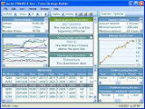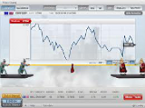Volatility Indicators
Volatility describes the day-to-day movement in prices (up or down). The theory is that a change in volatility tends to lead to a change in price.
For example: Bollinger Bands are volatility indicators and if the price touches or penetrates either band, it could indicate a price reversal. The distance (or gap) between the upper and lower bands indicates the volatility level – the wider the gap, the higher the volatility.
| Volatility Indicators | Useful in Forex? |
|---|---|
| Andrews’ Pitchfork | Yes |
| Chikou Span, Senkou Span, Tenkan Sen, Kijun Sen (Ichimoku) | Yes |
| Day Open Close | Yes |
| Envelope | Yes |
| Fibonacci Arcs, Fans, Retracements | Yes |
| Fractal | Yes |
| Gann Lines, Fans, Grids | Yes |
| Ichimoku | Yes |
| Linear Regression Channel | Yes |
| Linear Regression Trendline | No |
| Median Price | Yes |
| Pivot Points | No |
| Projection Bands | No |
| Projection Oscillator | No |
| Quadrant Lines | No |
| Speed Resistance Lines | No |
| Tirone Levels | No |
| Trendlines | Yes |
Forex Strategy Articles & News

There are many factors that affect exchange rates of currencies. However some are more important in currency trading than others. These are; Interest and Inflation rates, Trade balance, Currency market speculation, Foreign investment and Central bank market intervention. Learn how to use these factors in your forex tra ...


